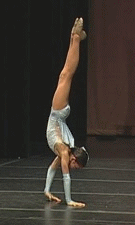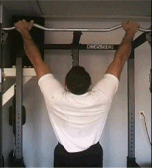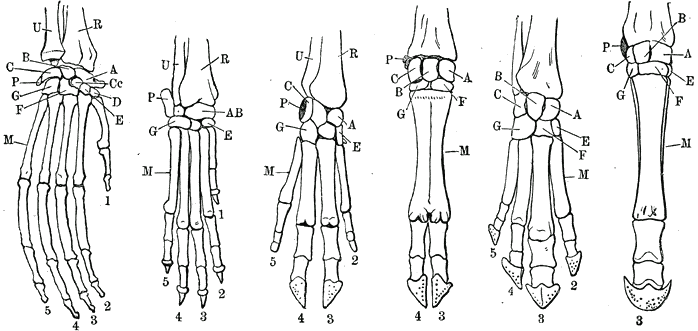|
Hand Walking
Hand walking is an unusual form of human locomotion in which a person travels in a vertically inverted orientation with all body weight resting on the hands. It can be executed with legs fully extended or with variations such as stag, straddle or front splits. Hand walking is performed in various athletic activities, including acro dance and circus acrobatics. Skills and technique Hand walking is a skill that relies on a prerequisite ability to perform handstands, which in turn requires adequate upper body pressing strength in the deltoids and triceps as well as a heightened sense of balance and spatial awareness. Because the body is inverted during hand walking, blood pressure in the brain is greater than normal. Hand walking often elicits automatic, alternating leg movements similar to upright bipedal locomotion. Research shows that these leg movements are caused in part by neural coupling between arm and legs. As with other physical skills, one must practice hand walking in ... [...More Info...] [...Related Items...] OR: [Wikipedia] [Google] [Baidu] |
Spatial Awareness
Spatial contextual awareness consociates contextual information such as an individual's or sensor's location, activity, the time of day, and proximity to other people or objects and devices.Chen, Guanling, and David Kotz. 2000. A Survey of Context-Aware Mobile Computing Research. Dartmouth Computer Science Technical Report TR2000-381. It is also defined as the relationship between and synthesis of information garnered from the spatial environment, a cognitive agent, and a cartographic map. The spatial environment is the physical space in which the orientation or wayfinding task is to be conducted; the cognitive agent is the person or entity charged with completing a task; and the map is the representation of the environment which is used as a tool to complete the task.Freksa, Christian, Alexander Klippel, and Stephan Winter. 2005. A Cognitive Perspective on Spatial Context. Dagstuhl Seminar Proceedings 05491. An incomplete view of spatial contextual awareness would render it as si ... [...More Info...] [...Related Items...] OR: [Wikipedia] [Google] [Baidu] |
Bodyweight Exercises
Bodyweight exercises (also called bodyweight workouts) are strength training exercises that use an individual's own weight to provide resistance against gravity. Bodyweight exercises can enhance a range of biomotor abilities including strength, power, endurance, speed, flexibility, coordination and balance. Such strength training has become more popular among recreational and professional athletes. Bodyweight training uses simple abilities like pushing, pulling, squatting, bending, twisting and balancing. Movements such as the push-up, the pull-up, and the sit-up are among the most common bodyweight exercises. Advantages While some exercises may require equipment, most bodyweight exercises require none. For exercises requiring equipment, common household items (such as a bath towel for towel curls) are often sufficient, or substitutes may be improvised (for example, using a horizontal tree branch to perform pull-ups). As such, bodyweight exercises are convenient while travelin ... [...More Info...] [...Related Items...] OR: [Wikipedia] [Google] [Baidu] |
Circus Skills
Circus skills are a group of disciplines that have been performed as entertainment in circus, sideshow, busking, or variety, vaudeville, or music hall shows. Most circus skills are still being performed today. Many are also practiced by non-performers as a hobby. Circus schools and instructors use various systems of categorization to group circus skills by type. Systems that have attempted to formally organize circus skills into pragmatic teaching groupings include the Gurevich system"The Classification of Circus Techniques" by Hovey Burgess. ''The Drama Review'': TDR, Vol. 18, No. 1, Popular Entertainments (Mar., 1974), pp. 65-70. doi:10.2307/1144863. (the basis of the Russian Circus School's curriculum) and the Hovey Burgess system. Circus skills * Acrobalance * Acrobatics * Acro dance * Adagio * Aerial hoop * Aerial silk * Aerial straps * Artistic cycling * Balancing * Banquine * Baton twirling * Buffoonery * Bullwhip * Bungee trapeze * Cannonball catching * Carnival ba ... [...More Info...] [...Related Items...] OR: [Wikipedia] [Google] [Baidu] |
Terrestrial Locomotion
Terrestrial locomotion has evolved as animals adapted from aquatic to terrestrial environments. Locomotion on land raises different problems than that in water, with reduced friction being replaced by the increased effects of gravity. As viewed from evolutionary taxonomy, there are three basic forms of animal locomotion in the terrestrial environment: * legged – moving by using appendages *limbless locomotion – moving without legs, primarily using the body itself as a propulsive structure. *rolling – rotating the body over the substrate Some terrains and terrestrial surfaces permit or demand alternative locomotive styles. A sliding component to locomotion becomes possible on slippery surfaces (such as ice and snow), where location is aided by potential energy, or on loose surfaces (such as sand or scree), where friction is low but purchase (traction) is difficult. Humans, especially, have adapted to sliding over terrestrial snowpack and terrestrial ice by means of ice ska ... [...More Info...] [...Related Items...] OR: [Wikipedia] [Google] [Baidu] |
Animal Locomotion
Animal locomotion, in ethology, is any of a variety of methods that animal (biology), animals use to move from one place to another. Some modes of locomotion are (initially) self-propelled, e.g., running, swimming, jumping, flying, hopping, soaring and gliding. There are also many animal species that depend on their environment for transportation, a type of mobility called Passive locomotion in animals, passive locomotion, e.g., sailing (some jellyfish), Ballooning (spider), kiting (spiders), rolling (some beetles and spiders) or riding other animals (phoresis (biology), phoresis). Animals move for a variety of reasons, such as to find Foraging, food, a Mating system, mate, a suitable microhabitat, or to Escape response, escape predators. For many animals, the ability to move is essential for survival and, as a result, natural selection has shaped the locomotion methods and mechanisms used by moving organisms. For example, Animal migration, migratory animals that travel vast dista ... [...More Info...] [...Related Items...] OR: [Wikipedia] [Google] [Baidu] |
Spotted Skunk
The genus ''Spilogale'' includes all skunks commonly known as spotted skunks. Currently, there are four accepted extant species: ''S. gracilis'', ''S. putorius'', ''S. pygmaea'', and ''S. angustifrons''. New research, however, proposes that there may be up to seven. Extant species In the past, anywhere between two and fourteen species of ''Spilogale'' have been recognized, but today most authorities accept a four species model (seen below). A 2021 DNA analysis of 203 specimens from across their known range suggests that there may be as many as seven distinct species in the genus, some cryptic. Description Mammalogists consider ''S. gracilis'' and ''S. putorius'' different species because of differences in reproductive patterns, reproductive morphology, and chromosomal variation. However, interbreeding has never been disproved. The name ''Spilogale'' comes from the Greek word ''spilo'', which means "spotted", and gale, which means "weasel". ''Putorius'' is the Latin word for " ... [...More Info...] [...Related Items...] OR: [Wikipedia] [Google] [Baidu] |
Anthropomorphic
Anthropomorphism is the attribution of human traits, emotions, or intentions to non-human entities. It is considered to be an innate tendency of human psychology. Personification is the related attribution of human form and characteristics to abstract concepts such as nations, emotions, and natural forces, such as seasons and weather. Both have ancient roots as storytelling and artistic devices, and most cultures have traditional fables with anthropomorphized animals as characters. People have also routinely attributed human emotions and behavioral traits to wild as well as domesticated animals. Etymology Anthropomorphism and anthropomorphization derive from the verb form ''anthropomorphize'', itself derived from the Greek ''ánthrōpos'' (, "human") and ''morphē'' (, "form"). It is first attested in 1753, originally in reference to the heresy of applying a human form to the Christian God.''Oxford English Dictionary'', 1st ed. "anthropomorphism, ''n.''" Oxford University P ... [...More Info...] [...Related Items...] OR: [Wikipedia] [Google] [Baidu] |
Forelimb
A forelimb or front limb is one of the paired articulated appendages (limbs) attached on the cranial ( anterior) end of a terrestrial tetrapod vertebrate's torso. With reference to quadrupeds, the term foreleg or front leg is often used instead. In bipedal animals with an upright posture (e.g. humans and some primates), the term upper limb is often used. A forelimb is not to be confused with a forearm, which is a distal portion of the human upper limb between the elbow and the wrist. All vertebrate forelimbs are homologous, meaning that they all evolved from the same structures. For example, the flipper of a turtle or of a dolphin, the arm of a human, the foreleg of a horse, and the wings of both bats and birds are ultimately homologous, despite the large differences between them. Specific uses of the forelimbs may be analogous if they evolved from different sub-structures of the forelimb, such as the flippers of turtles and dolphins, and the wings of birds and bats. Evolu ... [...More Info...] [...Related Items...] OR: [Wikipedia] [Google] [Baidu] |
Bipedal
Bipedalism is a form of terrestrial locomotion where an organism moves by means of its two rear limbs or legs. An animal or machine that usually moves in a bipedal manner is known as a biped , meaning 'two feet' (from Latin ''bis'' 'double' and ''pes'' 'foot'). Types of bipedal movement include walking, running, and hopping. Several groups of modern species are habitual bipeds whose normal method of locomotion is two-legged. In the Triassic period some groups of archosaurs (a group that includes crocodiles and dinosaurs) developed bipedalism; among the dinosaurs, all the early forms and many later groups were habitual or exclusive bipeds; the birds are members of a clade of exclusively bipedal dinosaurs, the theropods. Within mammals, habitual bipedalism has evolved multiple times, with the macropods, kangaroo rats and mice, springhare, hopping mice, pangolins and hominin apes ( australopithecines, including humans) as well as various other extinct groups evolving the ... [...More Info...] [...Related Items...] OR: [Wikipedia] [Google] [Baidu] |
Quadruped
Quadrupedalism is a form of locomotion where four limbs are used to bear weight and move around. An animal or machine that usually maintains a four-legged posture and moves using all four limbs is said to be a quadruped (from Latin ''quattuor'' for "four", and ''pes'', ''pedis'' for "foot"). Quadruped animals are found among both vertebrates and invertebrates. Quadrupeds vs. tetrapods Although the words ‘quadruped’ and ‘tetrapod’ are both derived from terms meaning ‘four-footed’, they have distinct meanings. A tetrapod is any member of the taxonomic unit Tetrapoda (which is defined by descent from a specific four-limbed ancestor), whereas a quadruped actually uses four limbs for locomotion. Not all tetrapods are quadrupeds and not all entities that could be described as ‘quadrupedal’ are tetrapods. This last meaning includes certain artificial objects; almost all quadruped ''organisms'' are tetrapods (with the exception of some raptorial arthropods adapted fo ... [...More Info...] [...Related Items...] OR: [Wikipedia] [Google] [Baidu] |
Balance (ability)
Balance in biomechanics, is an ability to maintain the line of gravity (vertical line from centre of mass) of a body within the base of support with minimal postural sway. Sway is the horizontal movement of the centre of gravity even when a person is standing still. A certain amount of sway is essential and inevitable due to small perturbations within the body (e.g., breathing, shifting body weight from one foot to the other or from forefoot to rearfoot) or from external triggers (e.g., visual distortions, floor translations). An increase in sway is not necessarily an indicator of dysfunctional balance so much as it is an indicator of decreased sensorimotor control. Maintaining balance Maintaining balance requires coordination of input from multiple sensory systems including the vestibular, somatosensory, and visual systems. * Vestibular system: sense organs that regulate equilibrium (equilibrioception); directional information as it relates to head position (internal gravitation ... [...More Info...] [...Related Items...] OR: [Wikipedia] [Google] [Baidu] |







